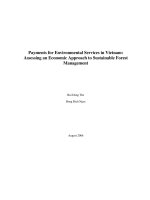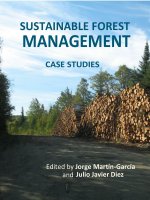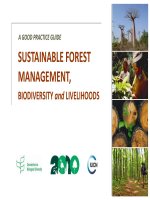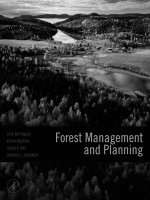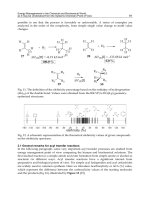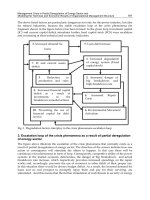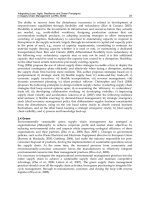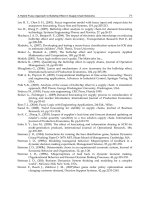SUSTAINABLE FOREST MANAGEMENT – CURRENT RESEARCH potx
Bạn đang xem bản rút gọn của tài liệu. Xem và tải ngay bản đầy đủ của tài liệu tại đây (26.71 MB, 468 trang )
SUSTAINABLE FOREST
MANAGEMENT – CURRENT
RESEARCH
Edited by Jorge Martín García
and Julio Javier Diez Casero
Sustainable Forest Management – Current Research
Edited by Jorge Martín García and Julio Javier Diez Casero
Published by InTech
Janeza Trdine 9, 51000 Rijeka, Croatia
Copyright © 2012 InTech
All chapters are Open Access distributed under the Creative Commons Attribution 3.0
license, which allows users to download, copy and build upon published articles even for
commercial purposes, as long as the author and publisher are properly credited, which
ensures maximum dissemination and a wider impact of our publications. After this work
has been published by InTech, authors have the right to republish it, in whole or part, in
any publication of which they are the author, and to make other personal use of the
work. Any republication, referencing or personal use of the work must explicitly identify
the original source.
As for readers, this license allows users to download, copy and build upon published
chapters even for commercial purposes, as long as the author and publisher are properly
credited, which ensures maximum dissemination and a wider impact of our publications.
Notice
Statements and opinions expressed in the chapters are these of the individual contributors
and not necessarily those of the editors or publisher. No responsibility is accepted for the
accuracy of information contained in the published chapters. The publisher assumes no
responsibility for any damage or injury to persons or property arising out of the use of any
materials, instructions, methods or ideas contained in the book.
Publishing Process Manager Romina Skomersic
Technical Editor Teodora Smiljanic
Cover Designer InTech Design Team
First published May, 2012
Printed in Croatia
A free online edition of this book is available at www.intechopen.com
Additional hard copies can be obtained from
Sustainable Forest Management – Current Research, Edited by Jorge Martín García and
Julio Javier Diez Casero
p. cm.
ISBN 978-953-51-0621-0
Contents
Preface IX
Section 1 Introduction 1
Chapter 1 Sustainable Forest Management:
An Introduction and Overview 3
Jorge Martín-García and Julio Javier Diez
Section 2 Carbon and Forest Resources 17
Chapter 2 The Quality of Detailed Land
Cover Maps in Highly Bio-Diverse Areas:
Lessons Learned from the Mexican Experience 19
Stéphane Couturier
Chapter 3 Sustainable Management of Lenga (Nothofagus pumilio)
Forests Through Group Selection System 45
Pablo M. López Bernal, Guillermo E. Defossé,
Pamela C. Quinteros and José O. Bava
Chapter 4 Remote Monitoring for Forest
Management in the Brazilian Amazon 67
André Monteiro and Carlos Souza Jr.
Chapter 5 Case Study of the Effects of the Japanese Verified
Emissions Reduction (J-VER) System on Joint Forest
Production of Timber and Carbon Sequestration 87
Tohru Nakajima
Section 3 Forest Health 109
Chapter 6 Cambial Cell Production and Structure of Xylem and
Phloem as an Indicator of Tree Vitality: A Review 111
Jožica Gričar
Chapter 7 Evaluating Abiotic Factors Related to Forest Diseases:
Tool for Sustainable Forest Management 135
Ludmila La Manna
Chapter 8 A Common-Pool Resource Approach to Forest Health:
The Case of the Southern Pine Beetle 151
John Schelhas and Joseph Molnar
Section 4 Protective and Productive Functions 165
Chapter 9 Ecological Consequences of Increased Biomass
Removal for Bioenergy from Boreal Forests 167
Nicholas Clarke
Chapter 10 Soil Compaction – Impact of Harvesters’
and Forwarders’ Passages on Plant Growth 179
Roman Gebauer, Jindřich Neruda, Radomír Ulrich
and Milena Martinková
Section 5 Biological Diversity 197
Chapter 11 Close-to-Nature Forest Management:
The Danish Approach to Sustainable Forestry 199
Jørgen Bo Larsen
Chapter 12 Ecological and Environmental Role of
Deadwood in Managed and Unmanaged Forests 219
Alessandro Paletto, Fabrizio Ferretti, Isabella De Meo,
Paolo Cantiani and Marco Focacci
Section 6 Socioeconomic Functions 239
Chapter 13 Multiple Services from Alpine Forests
and Policies for Local Development 241
Ilaria Goio, Geremia Gios, Rocco Scolozzi
and Alessandro Gretter
Chapter 14 Economic Valuation of Watershed
Services for Sustainable Forest Management:
Insights from Mexico 259
G. Perez-Verdin, J.J. Navar-Chaidez,
Y-S. Kim and R. Silva-Flores
Chapter 15 Market-Based Approaches
Toward the Development of Urban Forest
Carbon Projects in the United States 275
Neelam C. Poudyal, Jacek P. Siry and J. M. Bowker
Chapter 16 Implementation of the U.S. Legal, Institutional, and
Economic Criterion and Indicators for the 2010 Montreal
Process for Sustainable Forest Management 287
Frederick Cubbage, Kathleen McGinley, Steverson Moffat,
Liwei Lin and Guy Robertson
Section 7 Decision Making Tools 305
Chapter 17 How Timber Harvesting and Biodiversity
Are Managed in Uneven-Aged Forests:
A Cluster-Sample Econometric Approach 307
Max Bruciamacchie, Serge Garcia and Anne Stenger
Chapter 18 Models to Implement a Sustainable Forest Management –
An Overview of the ModisPinaster Model 321
Teresa Fonseca, Bernard Parresol, Carlos Marques
and François de Coligny
Chapter 19 The Effect of Harvesting on Mangrove Forest
Structure and the Use of Matrix Modelling to Determine
Sustainable Harvesting Practices in South Africa 339
Anusha Rajkaran and Janine B. Adams
Chapter 20 Individual-Based Models and Scaling Methods for Ecological
Forestry: Implications of Tree Phenotypic Plasticity 359
Nikolay Strigul
Chapter 21 Decision Support Systems for Forestry
in Galicia (Spain): SaDDriade 385
Manuel Francisco Marey-Pérez, Luis Franco-Vázquez,
and Carlos José Álvarez-López
Chapter 22 Application of Multi-Criteria Methods in Natural
Resource Management – A Focus on Forestry 404
Mario Šporčić
Chapter 23 A Decision-Support Model for Regulating Black Spruce
Site Occupancy Through Density Management 431
P. F. Newton
Preface
Sustainable forest management (SFM) is not a new concept. However, its popularity
has increased in the last few decades because of public concern about the dramatic
decrease in forest resources. SFM is generally implemented using criteria and
indicators (C&I) that define forest management standards, and several countries have
established their own sets of C&I within the framework of different international or
regional processes. Nevertheless, none of the C&I systems have been universally
accepted and future research should consider the current and future indicators.
This book summarises some of the recent research carried out to test the current
indicators, to search for new indicators and to develop new decision-making tools that
can be used in forest management to assess and implement SFM. The book is divided
into seven sections, including a brief introduction and six thematic blocks (carbon and
forest resources, forest health, productive and protective functions, biological
diversity, socioeconomic functions and decision making tools).
The Introduction provides an overview of SFM and forest certification. A brief analysis
of the current state of the World’s forests is presented, followed by a broad summary
of the past and current situation of SFM, C&I and forest certification, concluding with
future challenges.
The section on carbon and forest resources includes four articles. In the first paper,
Couturier describes the status of accuracy assessment of land use and land cover maps
and National Forest Inventory maps, and considers the usefulness of such maps for
implementing SFM in high biodiversity areas. The author also analyzes the accuracy
assessment methods used for four regions of Mexico. López-Bernal et al. contribute
with an interesting study of the evolution of Lenga forests in the Argentinean
Patagonia and the applicability of a selective silvicultural system, the “Group Selection
System”. These authors conclude that this system is a valid tool for making two key
aspects of SFM compatible. These aspects are optimal regeneration and the current
local production system, which is characterized by lack of financial and technological
capacity. Probably the most important challenge as regards SFM is the deforestation
and degradation of Amazon forests. Great efforts have been invested in deforestation
monitoring programs, although the high costs make this system unviable. Monteiro
and Souza Jr suggest the use of remote sensing techniques to detect, map and monitor
X Preface
logging activities at the scale of the Amazon, which would help improve forest
management, reduce illegal logging and improve the quality of harvesting. In the final
paper in this section, Nakajima discusses the effects of the Japanese carbon offsetting
system, with respect to carbon price, on the regional carbon stock and timber
production. The study uses simulations to investigate the effects of carbon price on
timber production and carbon stock, and examines the consequences for harvesting
strategies in the actual forest area formally identified in the Japanese Verified
Emissions Reduction system.
The section on forest health includes three papers. Gričar presents an interesting
review of the potential of xylem, phloem and cambium parameters as indicators of
tree vitality status. This author concludes that the ratio between xylem and phloem,
and to a lesser extent the widths of xylem, phloem and dormant cambium, are related
and indicate the health condition of a tree, and therefore may be used as indicators of
forest health. Traditionally forest health has been assessed at stand level. However,
entomologists and pathologists are conscious of the importance of landscape level for
detecting and preventing the spread of pests and diseases. In this regard, La Manna
describes some useful methods of evaluating the effects of abiotic factors on forest
diseases at landscape level and of developing risk models as tools for forest
management. The study by Schelhas and Molnar examines how sociological
perspectives on collective action and common-pool resource theory can contribute to
the health and management of Southern pine forests. Some implications for the
motivation of non industrial private forest owners and communication between them
are discussed.
The fourth section combines protective and productive functions, because a good
balance between the benefits of both is key to the success of SFM. This section
comprises two papers that evaluate the effect of harvesting intensity on water and soil.
Traditional forest management is changing due to a boom in renewable energy
sources, particularly forest biomass. The review by Clarke addresses the current state
of knowledge regarding sustainable removal of forest residues (branches and tops) for
bioenergy purposes, and the author concludes that this practice may increase the risk
of adverse effects on soil and water, among other effects. Soil compaction caused by
forestry machines is the subject of a paper by Gebauer et al. These authors determine
that the use of harvesters and forwarders without any prior site preparation is
detrimental to soil properties and plant growth, and they propose some options to
minimize such effects.
In the section on biological diversity, Larsen describes the history of nature-based
forest management, suggesting this as the best option for attaining the most natural
conditions in European forests, and discusses the Danish experience. The subject of
the paper by Paletto et al. is deadwood. These authors studied the effect of
management strategies on quantitative and qualitative features of deadwood, and
report some results that may be very useful in helping forest managers to meet SFM
demands.
Preface XI
From the previous sections it is clear that forests provide tangible and intangible
benefits. The latter have generally not been valued economically, and therefore were
underestimated until a few decades ago. In this regard, the different SFM initiatives
(ITTO, MCPFE, the Montreal Process, etc.) have established a criterion involving socio-
economic functions. The sixth section of the book, called Socioeconomic Functions,
consists of four papers that expect to advance in the economic assessment of intangible
benefits. The main objective of the paper by Goio et al. is to define the management
policies that maximise the use of goods and services, ensuring that forests are
managed sustainably. These authors focus on landscape and recreational function and
show the experiences from the Alps, in particular the Logarska Dolina valley (Trento,
Italy). The study by Perez-Verdin et al. focuses on hydrological services, specifically
the economic valorization of watershed services as a means of achieving SFM. The
authors analyze a case study in Mexico, where an incentive-based instrument
(payment for ecosystem services) was implemented. They conclude that although this
instrument is not the panacea for problems related to water quality and deforestation
problems, it should be considered in designing SFM policies. The paper by Poudyal et
al. provides a holistic view of the market potential and opportunities for making urban
forest projects financially self-reliant and more sustainable. This information could be
used to expand existing market protocols for carbon credits sourced from urban
forestry projects, and to develop new protocols. Finally, the paper by Cubbage et al.
deals with the legal, institutional, and economic C&I established for SFM in the U.S.
The section on decision-making tools includes seven papers. The development of
models to predict the effect of different silviculture scenarios is the subject of four of
the studies. Bruciamacchie et al. describe an economic model based on maximization
of incomes from harvesting in relation to biological diversity, and analyze the
demands for species diversity and timber supply and the link between timber
production and diversity. In the same vein, Fonseca et al. present the ModisPinaster
model as a useful tool for implementing SFM in maritime pine forests. This model
enables simulation of different silviculture scenarios, thus providing forest managers
with valuable information enabling them to achieve SFM standards. Moreover,
Rajkaran and Adams developed a model for determining the harvesting intensity in
mangrove forests, thus ensuring the viability of the tree population. The paper by
Strigul describes different models ranging from individual to stand level, which
incorporate the implications of crown plasticity for the optimization of the forest
resources as a novel aspect. These models enable prediction of the effects of different
management strategies or natural disturbances and provide a useful tool for forest
managers in the decision-making process. The study by Marey-Pérez et al. considers a
platform for Decision Support Systems in Galicia (Northern, Spain), which has proven
quite useful and has been directly applied to SFM. The paper by Šporčić describes how
multi-criteria methods can be used to analyze the choice of the best or at least
satisfactory decision and thus contribute to more reliable planning and more objective
decision making in forestry. The study by Newton describes an enhanced stand-level
decision-support model for managing upland black spruce stand-types and
XII Preface
demonstrates its operational utility in evaluating complex density management
regimes involving initial spacing, precommercial and commercial thinning.
The papers included in the book should shed light on the current research carried out
to provide forest managers with useful tools for choosing between different
management strategies or improving indicators of SFM. We are indebted to all authors
who submitted papers for consideration for publication in this book. We would also
like to thank the editorial team at Intech for their assistance and support.
Jorge Martín-García
1,2
and Julio Javier Diez
1
1
Sustainable Forest Management Research Institute,
University of Valladolid – INIA, Palencia,
2
Forestry Engineering, University of Extremadura, Plasencia,
Spain
Section 1
Introduction
1
Sustainable Forest Management:
An Introduction and Overview
Jorge Martín-García
1, 2
and Julio Javier Diez
1
1
Sustainable Forest Management Research Institute,
University of Valladolid – INIA, Palencia
2
Forestry Engineering, University of Extremadura, Plasencia
Spain
1. Introduction
It is well known that forests provide both tangible and intangible benefits. These benefits
may be classified according to ecological values (climate stabilization, soil enrichment and
protection, regulation of water cycles, improved biodiversity, purification of air, CO
2
sinks
,
potential source of new products for the pharmaceutical industry, etc.), social values
(recreational and leisure area, tradition uses, landscape, employment, etc) and economic
values (timber, non wood forest products, employment, etc.). Although forests have
traditionally been managed by society, it is expected that the current growth in the world
population (now > 7,000 million people) and the high economic growth of developing
countries will lead to greater use of natural resources and of forest resources in particular.
2. Global forest resources
The total forest area worldwide, previously estimated at 4 billion hectares, has decreased
alarmingly in the last few decades, although the rate of deforestation and loss of forest from
natural causes has slowed down from 16 million hectares per year in the 1990s to around 13
million hectares per year in the last decade (FAO, 2011). Nevertheless, the loss of forest
varies according to the region, and while the forest area in North America, Europe and Asia
has increased in the past two decades (1990-2010), it has decreased in other regions such as
Africa and Central and South America, and to a lesser extent Oceania (Fig. 1)
There is growing public concern about the importance of the environment and its
protection, as manifested by the fact that the total area of forest within protected systems
has increased by 94 million hectares in the past two decades, reaching 13% of all the world’s
forests. Moreover, designated areas for conservation of biological diversity and for
protection of soil and water account for 12 and 8% of the world’s forests, respectively (FAO,
2010, 2011). Nevertheless, other statistics such as the disturbing decrease in primary forests
1
(40 million hectares in the last decade) and the increase in planted forests (up to 7% of the
1
Forest of native species where there are no clearly visible indications of human activities and the
ecological processes have not been significantly disturbed (FAO, 2010)
Sustainable Forest Management – Current Research
4
world’s forests) (FAO, 2011) appear to indicate that to achieve forest sustainability, we must
go beyond analysis of the changes in the total forest area worldwide.
Fig. 1. State of World’s Forests 2011 – subregional breakdown (Source: FAO, 2011). Africa,
Asia, Europe, Central and South America and North America are represented in the left axis
and Oceania in the right axis.
3. Sustainable forest management
The concept of sustainability began to increase in importance at the end of the 1980s and at
the beginning of the 1990s with the Brundtland report (1987) and the Conference on
Environment and Development held in Rio de Janeiro, Brazil, in 1992 (the so-called Earth
Summit), respectively. Nevertheless, the need to preserve natural resources for use by future
generations had long been recognised.
The negative influence of past use of forest resources, as well as the needs for continued use
of these resources for future generations was already noted as early as the 17
th
century
(Glacken, 1976, as cited in Wiersum, 1995). However, it was not until the 18
th
century that
the concept of sustainability was specifically referred to, as follows: “every wise forest
director has to have evaluated the forest stands without losing time, to utilize them to the
greatest possible extent, but still in a way that future generations will have at least as much
benefit as the living generation” (Schmutzenhofer, 1992, as cited in Wiersum, 1995). This
first definition was based on the principle of sustainable forest yield, with the main goal
being sustained timber production, and it was assumed that if stands that are suitable for
timber production are sustained, then non wood forest products will also be sustained (Peng
2000). This assumption focused on the sustainability of the productive functions of forest
resources, while other functions such as ecological or socio-economic functions were largely
overlooked. This occurred because social demands for forests were mainly utilitarian.
However, increased environmental awareness and improved scientific knowledge
regarding deterioration of the environment have changed society’s values and the global
structural policy, which in turn have significantly influenced forest management objectives
in 20
th
century (Wang & Wilson, 2007). Nevertheless, nowadays more and more researchers
think climate change is changing the paradigm and sustainability shouldn’t be referred to
what we had before.
Although there is no universally accepted definition of SFM, the following concepts are
widely accepted: “the process of managing permanent forest land to achieve one or more clearly
specified objectives of management with regard to the production of a continuous flow of desired
forest products and services without undue reduction of its inherent values and future productivity
Sustainable Forest Management: An Introduction and Overview
5
and without undue undesirable effects on the physical and social environment” (proposed
by International Tropical Timber Organization: ITTO, 1992), and “the stewardship and
use of forests and forest lands in a way, and at a rate, that maintains their biodiversity, productivity,
regeneration capacity, vitality and their potential to fulfill, now and in the future, relevant
ecological, economic and social functions, at local, national, and global levels, and that does not cause
damage to other ecosystems” (proposed by the second ministerial conference for the protection
of the forest: MCPFE, 1993). The latter concept harmonizes ecological and socio-economic
concerns at different scales of management and for different time periods. Nevertheless,
both concepts are just refining the definition of sustainable development gave by the
Brundtland Commission (1987) “development that meets the needs of the present without
compromising the ability of future generations to meet their own needs” to apply it to
forests.
4. Criteria and indicators
The implementation of SFM is generally achieved using criteria and indicators (C&I).
Criteria are categories of conditions or processes whereby sustainable forest management
can be assessed, whereas quantitative indicators are chosen to provide measurable features
of the criteria and can be monitored periodically to detect trends (Brand, 1997; Wijewardana,
2008) and qualitative indicators are developed to describe the overall policies, institutions
and instruments regarding SFM (Forest Europe, 2011).
Different studies have pointed out the main characteristics of a good indicator. Thus, Prabhu
et al. (2001) suggested seven attributes to improve the quality of indicators (precision of
definition, diagnostic specificity, sensitivity to change or stress, ease of detection, recording
and interpretation, ability to summarize or integrate information, reliability and appeal to
users), whereas Dale & Beyeler (2001) established eight prerequisites to selection (ease of
measurement, sensitivity to stresses on the system, responsive to stress in a predictable
manner, anticipatory, able to predict changes that can be averted by management actions,
integrative, known response to disturbances, anthropogenic stresses and changes over time,
and low variability in response).
Although several criticisms have been launched against the C&I system (Bass, 2001;
Gough et al., 2008; Poore, 2003; Prabhu et al., 2001), the popularity of the system is evident
from the effort invested in its development in recent decades and from the large number
of countries that are implementing their own sets of C&I within the framework of the nine
international or regional process (African Timber Organization [ATO], Dry Forest in Asia,
Dry Zone Africa, International Tropical Timber Organization [ITTO], Lepaterique of
Central America, Montreal Process, Near East, Pan-European Forest [also known as the
Ministerial Conference on the Protection of Forest in Europe, MCPFE] and Tarapoto of the
Amazon Forest). Nevertheless, three of these processes stand out against the others
2
,
namely the ITTO, MCPFE and Montreal processes. The first set of C&I was developed by
ITTO (1992) for sustainable management of tropical forest, and subsequently an initiative
to develop C&I for sustainable management of boreal and temperate forests took place in
Canada, under the supervision of the Conference on Security and Cooperation, in 1993.
This first initiative reached a general consensus about the guidelines that should be
2
Together, these three international C&I processes represent countries where more than 90% of the
world’s temperate and boreal forests, and 80% of the world’s tropical forests are located.
Sustainable Forest Management – Current Research
6
followed by all participating countries. It was then decided that the countries should be
split into two groups: European would establish the MCPFE and non-European countries
the Montreal processes. The MCPFE process adopted a first draft of C&I in the first expert
level follow-up meeting in Geneva in June 1994, which took shape in Resolution L2
adopted at the third Ministerial Conference on the Protection of Forest in Europe held in
Lisbon (MCPFE, 1998), and improved at the subsequent Ministerial Conference held in
Vienna (MCPFE, 2003). On the other hand, the Montreal process established its set of C&I
in the Santiago Agreement (1995), with Criteria 1-6 improved at the 18th meeting in
Buenos Aires, Argentina (TAC, 2007) and criterion 7 improved at the 20th meeting in Jeju,
Republic of Korea (TAC, 2009).
Although the different processes have very different origins and have developed their own
criteria, there are some similarities between the three major SFM programs (Table 1). The
main difference concerns criterion 7, developed by the Montreal process (Legal, policy and
institutional framework), which was imbedded within each of the criteria in the MCPFE
process (McDonald & Lane, 2004) and the concept of which is similar to criterion 1 in the
ITTO process (Enabling condition). One important difference between ITTO and the other
two processes is that the former does not consider maintenance of the forest contribution to
global carbon cycles.
ITTO process MCPFE process Montreal process
C1. Enabling
condition
C1. Maintenance and appropriate
enhancement of forest resources and
their contribution to global carbon
cycles
C1. Conservation of biological
diversity
C2. Extent and
condition of forests
C2. Maintenance of forest ecosystem
health and vitality
C2. Maintenance of productive
capacity of forest ecosystems
C3. Forest ecosystem
health
C3. Maintenance and encouragement
of productive functions of forests
(wood and non-wood)
C3. Maintenance of forest
ecosystem health and vitality
C4. Forest
production
C4. Maintenance, conservation and
appropriate enhancement of
biological diversity in forest
ecosystems
C4. Conservation and
maintenance of soil and water
resources
C5. Biological
diversity
C5. Maintenance and appropriate
enhancement of protective functions
in forest management (notably soil
and water)
C5. Maintenance of forest
contribution to global carbon
cycles
C6. Soil and water
protection
C6. Maintenance of other
socioeconomic functions and
conditions
C6. Maintenance and
enhancement of long-term
multiple socio-economic
benefits to meet the needs of
societies
C7. Economic, social
and cultural aspects
C7. Legal, policy and
institutional framework
Table 1. Criteria for sustainable forest management: comparison of three major programs
Sustainable Forest Management: An Introduction and Overview
7
Other differences in indicators developed by the different processes have become apparent,
and e.g. Hickey & Innes (2008) established more than 2000 separate indicators using the
context analysis method. There are also substantial differences as regards the three major
processes: the MCPFE process has 52 indicators (MCPFE, 2003), whereas the Montreal
process has reduced the number of indicators from 67 (Santiago Agreement, 1995) to 54
(TAC, 2009), and the ITTO process has reduced the number of indicators from 66 in the first
revision (ITTO, 1998) to the 56 considered at present (ITTO, 2005).
In light of the proliferation of C&I processes, the need to achieve harmonization has been
widely recognised (Brand, 1997; Castañeda, 2000). Although the concept of harmonization is
subject to several interpretations, harmonization should not be mistaken for standardization
(Rametsteiner, 2006). Köhl et al (2000) has claimed that “harmonization should be based on
existing concepts which should be brought together in a way to be more easy to compare,
which could be seen as a bottom up approach starting from an existing divergence and
ending in a state of comparability”. Although there is not yet a common approach,
considerable efforts have been made since the first expert meeting on the harmonization of
Criteria and Indicators for SFM, held in Rome in 1995 (FAO, 1995), towards the search for a
harmonization/collaboration among C&I processes through the Inter-Criteria and Indicator
Process Collaboration Workshop (USDA, 2009). Advances in harmonization will minimise
costs (avoiding duplication and preventing overlap), facilitate comparisons between
countries and, overall, improve the credibility of SFM.
Although indicators are increasingly used, their utility is still controversial. Some authors
have pointed out several weaknesses of the indicators, e.g. that they are often highly
idealistic (Bass, 2001; Michalos, 1997), that they are a pathological corruption of the
reductionist approach to science (Bradbury, 1996) or even that the same indicator may lead
to contradictory conclusions according to the criterion and the scale. Nevertheless, there is
general agreement that the advantages of the approach outweigh these limitations and that
researchers should focus their efforts on testing the current indicators and searching for new
indicators.
There are two key aspects involved in improving the current and future indicators, the use
of a suitable scale and the establishment of a specific interpretation of each indicator.
Although these have mainly been implemented at a national level, sub-national and forest
management unit (FMU) levels are essential to assess SFM (Wijewardana, 2008). The FMU
level has been considered as the finest scale in C&I processes. However it is well-known that
for some indicators (mainly biodiversity indicators), another subdivision within this level
may be necessary, such as plot, landscape and spatial levels, for correct interpretation
(Barbaro et al., 2007; Heikkinen et al., 2004). In light of this level of precision and the fact that
values of indicators are sometimes correlated with several different scales, managers and
researchers should establish the most effective scale in each case, to avoid additional
charges. Moreover, good indicators are not always easy to interpret in terms of
sustainability, because most indicators do not exhibit a clear distinction/threshold between
sustainability and unsustainability. In such cases, the achievement of sustainability should
be considered on the basis of relative improvement in the current status of the indicator in
question (Bertrand et al., 2008).
On the other hand, the scientific community must search for new indicators. Gaps in
knowledge have been identified, and as these mainly involve ecological aspects, researchers
should go further in investigating the relationships between type of forest management and
Sustainable Forest Management – Current Research
8
ecological and socioeconomic functions. Thus, managers and researchers, with the support
of scientific knowledge and public consultations, should be able to determine feasible goals,
from socioeconomic and scientific points of view, since goals that are too pretentious may
lead to a situation whereby SFM will not be promoted (Michalos, 1997). Only then can
successful selection of new indicators of SFM be achieved.
5. Forest certification
In addition to the efforts of different states to develop C&I in the last two decades, a parallel
process has been developed to promote SFM. This process is termed “forest certification”.
Forest certification can be defined by a voluntary system conducted by a qualified and
independent third party who verifies that forest management is based on a predetermined
standard and identifies the products with a label. The standard is based on the
C&I approach and the label, which can be identified by the consumer, is used to
identify products. Therefore, the two main objectives of forest certification are to improve
forest management (reaching SFM) and to ensure market access for certified products (Gafo
et al., 2011).
The first certification was carried out in Indonesia in 1990 by the SmartWood programme of
the Rainforest Alliance (Crossley, 1995, as cited in Elliot, 2000). However forest certification
became popular after The Earth Summit in Rio de Janeiro in 1992. Although important
advances were reached at this summit, the failure to sign a global convention on forestry led
environmental and non-governmental organizations to establish private systems of
governance to promote SFM. In 1993, an initiative led by environmental groups, foresters
and timber companies resulted in creation of the Forest Stewardship Council (FSC).
Subsequently, other initiatives at international and national levels gave rise to many other
schemes, e.g. the Programme for the Endorsement of Forest Certification (PEFC, previously
termed Pan European Forest Certification), the Canadian Standards Association (CSA), the
Sustainable Forestry Initiative (SFI), the Chile Forest Certification Corporation (CERTFOR)
and the Malaysian Timber Certification Council, among others.
The area of certified forest increased rapidly in the 1990s and from then on more gradually,
reaching 375 million hectares in May 2011 (UNENCE/FAO, 2011), which represents almost
10% of the global forest area. Although many forest certification systems were developed in
the 1990s, only two schemes (PEFC and FSC) have been used for most of the forest currently
certified throughout the world. The FSC scheme was established in 1993 to close the gap
identified after the Earth Summit, and with more than 140 million hectares is the first
program in terms of number of certified countries (81 countries) and the second system in
terms of certified area at the moment (FSC, 2011). The PEFC scheme was established in 1999
as an alternative to the FSC scheme, and was led by European forest owners, who
considered that FSC standards mainly applied to large tropical forests, but were
inappropriate for small forest owners of European temperate forests. The PEFC scheme
has gained importance because it endorses 30 national forest certification systems
(Australian Forestry Standard, CSA, SFI, CERTFOR, etc.), and with more than 230 million
hectares of certified forests is currently the largest forest certification system (PEFC, 2011).
Although several authors have reported significant differences between FSC and PEFC
(Clark & Kozar, 2011; Rotherham, 2011; Sprang, 2001), detailed analysis has revealed that
FSC and PEFC are highly compatible, despite having arrived at their C&I by different routes
(ITS Global, 2011).
Sustainable Forest Management: An Introduction and Overview
9
Although forest certification began in tropical forests, the trend has changed and the scheme
is now carried out in boreal and temperate forests. Almost 90% of forests certified by the
two major programs (FSC and PEFC) are located within Europe and North America (Figure
2). More than half (54%) of the forests in Europe (excluding the Russian Federation) have
already been certified, and almost one third of the forest area in North America has been
certified (Figure 3). On the contrary, only about 1.5% of the forests in Africa, Asia, and
Central and South America have been certified (Figure 3), despite the fact that more of half
of the world’s forests and almost 60% of primary world forests are located in these
countries. The FSC and PEFC schemes display similar patterns of certification, since both
mainly certify forests in Europe and North America. However, although the percentage of
forest area certified by FSC in Africa, Asia, and Central and South America is only 16% of all
certifications carried out by this scheme, this represents 75% of the forest areas certified in
these regions. Furthermore, almost all certifications carried out in the Russian Federation are
carried out by the FSC, whereas the PEFC has certified very few forests in this region. On
the other hand, most forest certifications in Europe (excluding the Russian Federation) and
North America have been carried out by PEFC (Figure 2).
Fig. 2. Global FSC and PEFC certified forest area November 2011 – subregional breakdown
(Source: FSC, 2011; PEFC, 2011)
Fig. 3. Percentage of certified forest area, by both FSC and PEFC schemes, November 2011 –
subregional breakdown (Source: FSC, 2011; PEFC, 2011)
Sustainable Forest Management – Current Research
10
Forest certification has became very popular, mainly because it is regarded it as a tool
whereby everyone should benefit (win-win situation): forest owners should have an
exclusive market with premium prices, the forest industry should improve its green
corporate image, should not be held responsible for deforestation, and should have
available a market tool, consumers should be able to use forest products with a clear
conscience, and overall, forests should be managed sustainably.
The concept of forest certification is based on an economic balance, where forest owners and
the forest industry place sustainable products on the market in the hope that consumers will
be willing to pay the extra cost implied by SFM. Nevertheless, forest certification is still far
from reaching its initial goal (win-win), since the expected price increases have not occurred
(Cubbage et al., 2010; Gafo et al., 2011). In practice, only consumers and the forest industry
have benefited; consumers use certified forest products with a clear conscience, and the
forest industry has ensured market access without any great extra cost because this has
mainly been assumed by forest owners.
This leads to a difficult question, namely, are forests benefiting from forest certification? It
appears logical to believe that forest certification is beneficial to forests, since forest owners
must demonstrate that the forests are being managed sustainably. Nevertheless, in depth-
analysis reveals a different picture. As already noted, forest certification began in tropical
forests with the aim of decreasing deforestation. However, nowadays almost all certified
forests are located in developed countries. Furthermore, most of these forests are productive
forests, such as single-species and even-aged forests or plantations, in which only small
changes must be made to achieve forest certification, while primary forests have largely
been ignored. The fact that foresters are able to place certified products from productive
forests on the market, with a small additional charge compared to the extra charge involved
in certifying products from primary forests hinders certification of the latter, which are
actually the most endangered forests. Moreover, this disadvantage may favour
unsustainable management, such as illegal logging or in extreme cases conversion of forest
land to agricultural land, to favour market competitiveness. Against this background, other
initiatives beyond of forest certification has been implemented, such as the FLEGT (Forest
Law Enforcement, Governance and Trade) Action Plan of the European Union that provides
a number of measures to exclude illegal timber from markets, to improve the supply of legal
timber and to increase the demand for wood coming from responsibly managed forests
(www.euflegt.efi.int) or the REDD (Reducing Emissions from Deforestation and Forest
Degradation) initiative of the United Nations to create a financial value for the carbon stored
in forests, offering incentives for developing countries to reduce emissions from forested
lands and invest in low-carbon paths to sustainable development, including the role of
conservation, sustainable management of forests and enhancement of forest carbon stocks
(www.un-redd.org).
In addition, some environmental organizations now consider that plantations should not be
certified, since they consider that plantations are not real forests. Such organizations also
denounce the replacement of primary forests with plantations in developing countries
(WRM, 2010). Although the replacement of primary forests with plantations is a damaging
process, replacement of degraded areas such as abandoned pasture or agricultural land
provides obvious advantages from economic and ecological points of view (Brockerhoff et
al., 2008; Carnus et al., 2006; Hartley, 2002). The two most important schemes (FSC and
PECF) approve the certification of forest plantations because they believe that the promotion
of wood products from plantations will help to reduce the pressure on primary forests. The
Sustainable Forest Management: An Introduction and Overview
11
FSC has added another principle (Principle 10: Plantations) in an attempt to ensure SFM in
plantations, while the PECF considers that its criteria and indicators are sufficient to ensure
the sustainability of planted forests. The FORSEE project was carried out in order to test the
suitability of MCPFE indicators (which are used as the basis for PEFC certification in
Europe) for planted forests at a regional level in eight Atlantic regions of Europe (Tomé &
Farrell, 2009). This project concluded that with few exceptions, the MCPFE criteria and
indicators appear suited to assess the sustainable management of forests, although it was
pointed out that they should be considered as a blueprint for true SFM and adaptations are
needed at the local level (Martres et al., 2011).
The viability of tropical forest certification will depend on forest owners obtaining premium
prices that at least cover the certification costs, taking into account that these costs vary
according to the type of forest (primary forest, plantations, etc.) and that consumers’
willingness to pay premium prices will also differ. It should be possible for consumers to
distinguish the origin of each product, and in other words different labels are required.
Nevertheless, the use of different eco-labels is controversial, since many labels may confuse
rather than help consumers. Teisl et al (2002) noted that consumers “seem to prefer
information presented in a standardized format so that they can compare the environmental
features between products” and highlighted “the need for education efforts to both
publicize and inform consumers about how to use and interpret the eco-labels”. Both of
these are difficult tasks when different certifiers are rivals in the market place.
Without standardization and a powerful information campaign, most environmentally
concerned consumers will probably demand wood from sustainably managed forests,
without taking into account the type of certification label, and will choose the least
expensive product (Teisl et al., 2002). This may entail a new associated problem, since
producers and industries will probably also choose the bodies that certify forests most
readily and at the lowest cost. This may lead to a situation where the certification schemes
would tend to compete with each other and standards would be reduced to attract
producers, as pointed out by Van Dam (2001).
6. Conclusion
Sustainable forest management is evolving with public awareness and scientific knowledge,
and the sustainability concept must be revised to reflect the new reality generated by climate
change, where a past reference point shouldn’t be considered. Therefore, C&I should be
updated continuously to be able to cope with the climate change challenge and assess
sustainability of changing ecosystems. Furthermore, harmonization of C&I processes would
be the most desirable outcome, since this would improve the credibility of the schemes.
On the other hand, forest certification has failed to avoid deforestation and has got two main
challenges;
(1) to certify the forests that are most important in ecological terms and that are most
susceptible to poor forest management, such as tropical forests and, to a lesser extent, non
productive forest in boreal and temperate regions, and (2) to achieve a market with
premium prices, in which the win-win concept will prevail. This will require educational
campaigns and a higher level of credibility for labels. Moreover, parallel initiatives, such as
FLEG and REDD, considering outside forest sector drivers leading to deforestation should
be taking into account to limit this process.
